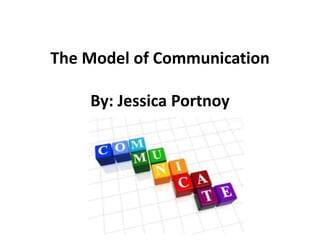
The model of communication
- 1. The Model of Communication By: Jessica Portnoy
- 2. Communication • Communication starts with an issue, feeling, thought, or some information from a sender to listener. • Communication is such a beautiful thing. It allows you to explore, listen, think, hear, find out about someone, receive information. • Communication can occur through letters, telephone. Communication can even occur through signals.
- 3. Sender • A sender is considered the source of the message. • The sender’s role is to send messages that are understandable to the listener(s). • The sender’s communication skills involves a couple of things like: Listening, writing, speaking, reading, thinking, reasoning.
- 4. Encoding • Encoding is the process where information from a source is converted into symbols that are verbal and/or nonverbal that are to be articulated. • The entire encoding process involves different things like culture, your gender influences, expectations, language, social system. • Success in encoding actually depends on your ability to transfer information as clearly as possible. • With encoding you should avoid things that are confusing (for example, certain issues, mistaken assumptions, and types of missing information.) • You need to know who you are communicating with.
- 5. Message • The message is the object of communication. This is what the person wants his or her listener(s) to know. • A message is a thought or idea expressed in a language. • A verbal message can be an exchange of words. Through a telephone, face to face, a voicemail. • A nonverbal message is exchanged through actions or behaviors. Either through body language or any action in general.
- 6. Channel • A channel is through which the message has to pass. The channel can be spread to certain audience. • With a channel your senses are involved. Your five senses are: sound, touch, taste, smell, and sight. • The type of selection of channels is extremely important when it comes to the achievement of communication. • The message passes through the channel as it touches base with the receiver.
- 7. Receiver • The receiver is the person who is intended to receive the message. • The receiver could be the ultimate target. It could even be a group of people who are intended to receive the message. • The receiver listens to the message and even though the receiver is not the one who starts the message, they are the ones who grant opinion. • It is important you know who you are sending the message to.
- 8. Decoding • Decoding is the basic acknowledgement and understanding of what a text actually says. • Pretty much, Decoding is the one that translates your message data into some sort of character that he/she can understand. • The same thing that goes for encoding also affects decoding.
- 9. Feedback • Feedback is probably one of the most important well semi important ones out of them all. • Feedback is he/she’s response to your message. With feedback you are able to evaluate the message. The way to continue a conversation is with feedback. You need to hear what the other person has to say. • You have to watch out with the type of feedback your provide because everyone interprets things differently.
- 10. Noise • Noise is anything that inhibits with the message. • This could things such as someone sneezing next to you or someone who is upset and will do anything they can to disrupt the message. • Noise can happen at anytime, any day.
- 11. THE END! I hope you enjoyed my PowerPoint and remember always be clear when you are communicating!